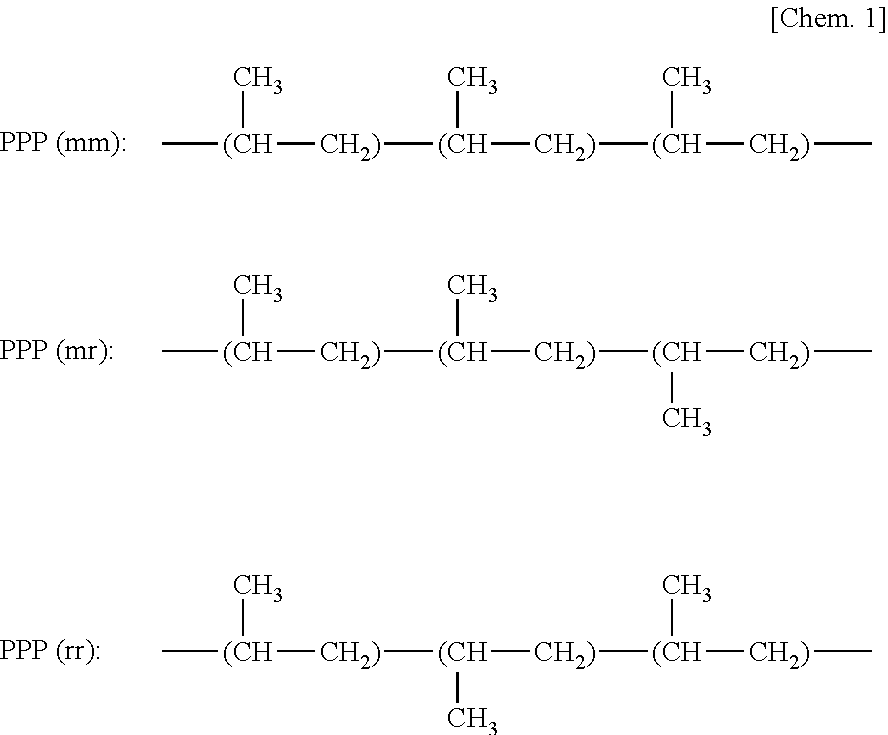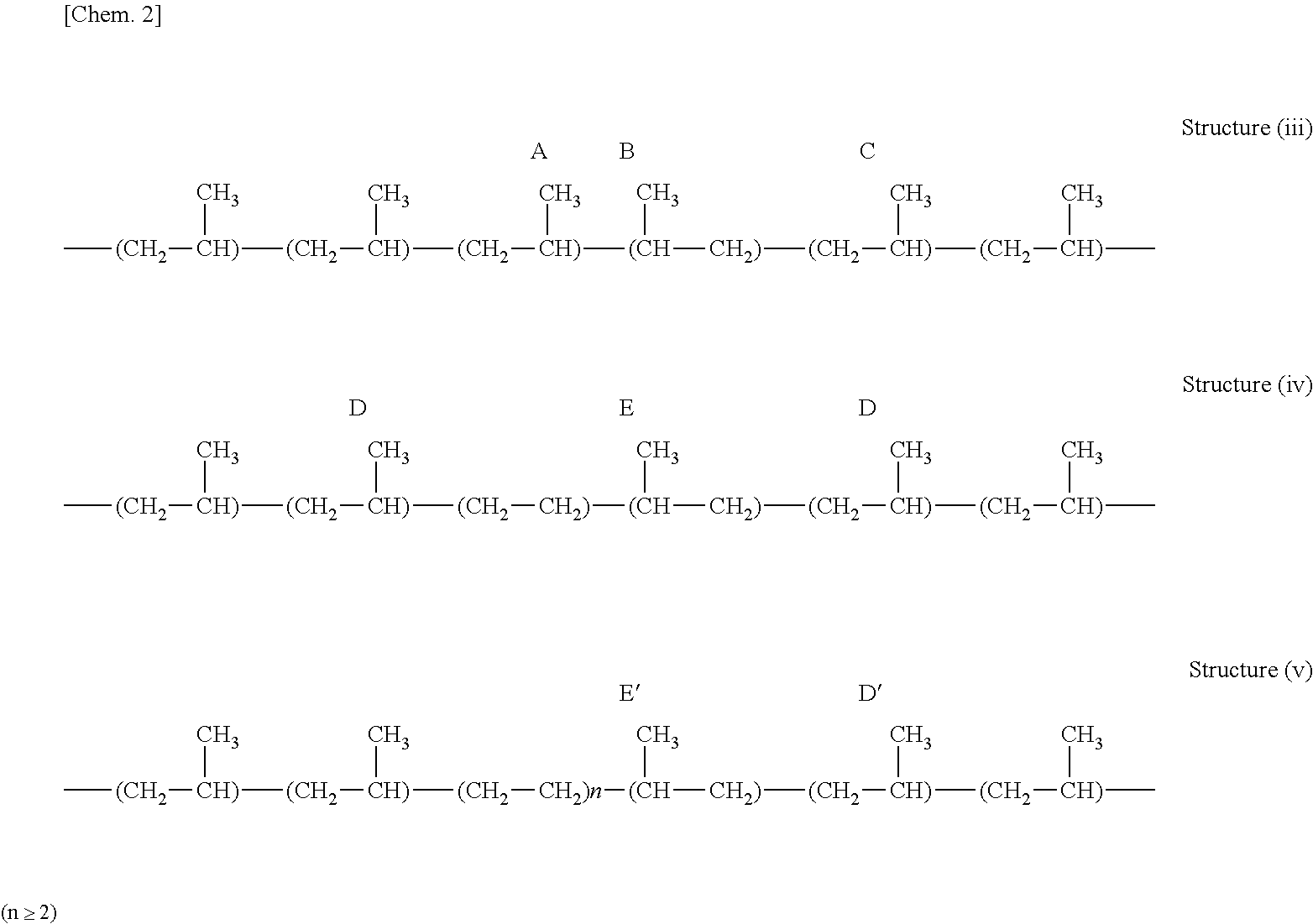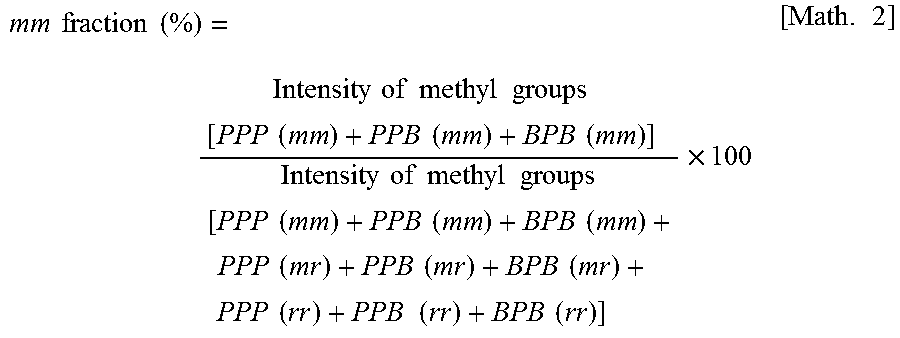Graft-modified propylene alpha-olefin copolymers and methods for producing the same
a technology of propylene polymer and alpha-olefin, which is applied in the field of graft-modified propylene alpha-olefin copolymers, can solve the problems of poor adhesion of propylene polymers to certain materials, metals and polar resins, and inability to meet the requirements of heat resistance and heat sealing, and achieve stable emulsion properties, high yield, and high bond strength
- Summary
- Abstract
- Description
- Claims
- Application Information
AI Technical Summary
Benefits of technology
Problems solved by technology
Method used
Image
Examples
production example 1
[0121]A 2-L autoclave that had been thoroughly purged with nitrogen was charged with 900 ml of hexane and 90 g of 1-butene, and 1 mmol of triisobutylaluminum was added. The temperature was increased to 70° C., and propylene was supplied to control the total pressure to 7 kg / cm2G. Further, 0.30 mmol of methylaluminoxane, and 0.001 mmol in terms of Zr atoms of rac-dimethylsilylene-bis{1-(2-methyl-4-phenylindenyl)}zirc onium dichloride were added. Polymerization was performed for 30 minutes while continuously supplying propylene to maintain the total pressure at 7 kg / cm2G. After the polymerization, the autoclave was depressurized and the polymer was recovered in a large amount of methanol. The polymer was vacuum dried at 110° C. for 12 hours.
[0122]The propylene.α-olefin polymer (a-1) obtained weighed 39.7 g, and the polymerization activity was 79 kg·polymer / mmol Zr·hr. The polymer contained 74 mol % of propylene-derived units and 26 mol % of 1-butene-derived units, and had a MFR of 7 g...
production examples 2 and 3
[0123]Propylene.α-olefin polymers (a-2) and (a-3) were obtained in the same manner as in Production Example 1, except that the amount of 1-butene was changed. The amounts of 1-butene used in the polymers (a-2) and (a-3) are described in Table 2. The production example in which the polymer (a-2) was obtained was Production Example 2, and the production example which afforded the polymer (a-3) was Production Example 3. The properties of the polymers (a-2) and (a-3) are described in Table 2. The propylene.α-olefin polymers (a-2) and (a-3) satisfy the relationship specified in the requirement (5): −2.6M+130≦T≦−2.3M+155, and satisfy the relationship specified in the requirement (6): C≧−1.5M+75.
production example 4
[0124]A 2-L polymerizer that had been thoroughly purged with nitrogen was charged with 833 ml of dried hexane, 100 g of 1-butene, and triisobutylaluminum (1.0 mmol) at room temperature. The temperature inside the polymerizer was increased to 40° C., and the pressure in the system was increased to 0.76 MPa with propylene. Thereafter, the pressure in the system was controlled to 0.8 MPa with ethylene. Next, a toluene solution in which 0.001 mmol of dimethylmethylene(3-t-butyl-5-methylcyclopentadienyl)fluor enylzirconium dichloride was in contact with 0.3 mmol in terms of aluminum of methylaluminoxane (manufactured by TOSOH FINECHEM CORPORATION) was added to the polymerizer. Polymerization was performed for 20 minutes at an inside temperature of 40° C. while maintaining the pressure in the system at 0.8 MPa with ethylene. The polymerization was terminated by the addition of 20 ml of methanol. The polymerizer was depressurized, and the polymerization solution was poured into 2 L of meth...
PUM
| Property | Measurement | Unit |
|---|---|---|
| mol % | aaaaa | aaaaa |
| mol % | aaaaa | aaaaa |
| mol % | aaaaa | aaaaa |
Abstract
Description
Claims
Application Information
 Login to View More
Login to View More - R&D
- Intellectual Property
- Life Sciences
- Materials
- Tech Scout
- Unparalleled Data Quality
- Higher Quality Content
- 60% Fewer Hallucinations
Browse by: Latest US Patents, China's latest patents, Technical Efficacy Thesaurus, Application Domain, Technology Topic, Popular Technical Reports.
© 2025 PatSnap. All rights reserved.Legal|Privacy policy|Modern Slavery Act Transparency Statement|Sitemap|About US| Contact US: help@patsnap.com



